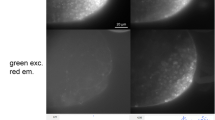Abstract
The pattern of intense fluorescence of interphase nuclei and metaphase chromosomes after staining with quinacrine is described in Samoaia leonensis. Autoradiographic analysis of interphase nuclei after pulse labeling with tritiated thymidine indicates that there is little or no overlap in the time of replication of the intensely fluorescing and weakly fluorescing regions. Autoradiographic analysis of metaphase figures after continuous labeling with tritiated thymidine shows that the intensely fluorescing regions are late replicating and establishes their order of replication. Autoradiographic analysis of interphase nuclei after pulse labeling with tritiated deoxycytidine and of metaphase figures after continuous labeling with this tracer show that there is little, if any, incorporation of deoxycytidine into those chromosome regions which fluoresce intensely after staining with quinacrine and quinacrine mustard. These results indicate that such chromosome regions are characterized chemically by an extremely high, if not exclusive, content of adenine and thymine.
Similar content being viewed by others
References
Adkisson, K. P., Perreault, W. J., and Gay, H.: Differential fluorescent staining of Drosophila chromosomes with quinacrine mustard. Chromosoma (Berl.) 34, 190–205 (1971).
Barigozzi, C., Dolfini, S., Fraccaro, M., Rezzonico Raimondi, G., Tiepolo, L.: In vitro study of the DNA-replication patterns of somatic chromosomes of Drosophila melanogaster. Exp. Cell Res. 43, 231–234 (1966).
Barr, H. J., Ellison, J. R.: Quinacrine staining of chromosomes and evolutionary studies in Drosophila. Nature (Lond.) 223, 190–191 (1971a).
Barr, H. J., Ellison, J. R.: Correlation of quinacrine staining and ectopic pairing of specific regions of Drosophila polytene chromosomes. Amer. Zool. 11, 682 (1971b).
Blumenfeld, M., Forrest, H.: Is Drosophila DAT on the Y chromosome ? Proc. nat. Acad. Sci. (Wash.) 68, 3145–3149 (1971).
Britten, R. J., Davidson, E. H.: Repetitive and nonrepetitive sequences and a speculation on the origins of evolutionary novelty. Quart. Rev. Biol. 46, 111–138 (1971).
Caro, L. G., Tubergen, R. P. van: High-resolution autoradiography. I. Methods. J. Cell Biol. 15, 173–188 (1962).
Caspersson, T., Farber, S., Foley, G. B., Kudynowski, J., Modest, E. J., Simonsson, E., Wagh, U., Zech, L.: Chemical differentiation along metaphase chromosomes. Exp. Cell Res. 49, 219–222 (1968).
Caspersson, T., Zech, L., Modest, E.: Fluorescent labeling of chromosomal DNA-Superiority of quinacrine mustard to quinacrine. Science 170, 762–764 (1970).
Comings, D. E.: Heterochromatin of the Indian muntjac. Exp. Cell Res. 67, 441–460 (1971).
Commoner, B.: Roles of deoxyribonucleic acid in inheritance. Nature (Lond.) 203, 486–491 (1964).
Ellison, J. R.: A cytological study of some species of the genus Samoaia (Diptera: Drosophilidae). Univ. of Texas Publ. 6818 (Studies in Genetics, IV) (M. R. Wheeler, ed.), p. 421–430 (1968).
Ellison J. R.: The nucleolar chromatin in Drosophila polytene cells. A doctoral dissertation. University of Oregon, Dept. of Biology, Appendix III (1970).
Ellison, J. R., Barr, H. J.: Chromosome variation within Drosophila simulans detected by quinacrine staining. Genetics 69, 119–122 (1971a).
Ellison, J. R., Barr, H. J.: Differences in the quinacrine staining of the chromosomes of a pair of sibling species: Drosophila melanogaster and Drosophila simulans. Chromosoma (Berl.) 34, 424–435 (1971b).
Fansler, B. S., Travaglini, E. C., Loeb, L. A., Schultz, J.: Structure of Drosophila melanogaster dAT replicated in an in vitro system. Biochem. biophys. Res. Commun. 40, 1266–1272 (1970).
Gall, J. G., Pardue, M. L.: Nucleic acid hybridization in cytological preparations. In: Methods in enzymology vol. XXI, nucleic acids, part. D. (L. Grossman and K. Moldave, eds.). New York: Academic Press 1971.
Kurnick, N. B., Radcliffe, I. E.: Reaction between DNA and quinacrine and other antimalarials. J. Lab. clin. Med. 60, 669–688 (1962).
Lerman, L. S.: The structure of the DNA-acridine complex. Proc. nat. Acad. Sci. (Wash.) 49, 94–101 (1963).
Lima-de-Faria, A.: Differential uptake of tritiated thymidine in hetero- and euchromatin in Melanoplus and Secale. J. biophys. biochem. Cytol. 6, 457 (1959).
Malloch, J. R.: Insects of Samoa, Part VI. Fasc. 8, p. 267–312 (1934).
Nash, D., Plaut, W.: On the denaturation of chromosomal DNA in situ. Proc. nat. Acad. Sci. (Wash.) 51, 731–735 (1964).
Ohno, S.: Evolution by gene duplication. Berlin-Heidelberg-New York: Springer 1970.
Pearson, P. L., Bobrow, M., Vosa, C. G., Barlow, P. W.: Quinacrine fluorescence in mammalian chromosomes. Nature (Lond.) 231, 326–329 (1971).
Taylor, J. H.: Asynchronous duplication of chromosomes in cultured cells of Chinese hamster. J. biophys. biochem. Cytol. 7, 455–464 (1960).
Vosa, C. G.: The discriminating fluorescence patterns of the chromosomes of Drosophila melanogaster. Chromosoma (Berl.) 31, 446–451 (1970).
Vosa, C. G.: The quinacrine-fluorescence patterns of the chromosomes of Allium carinatum. Chromosoma (Berl.) 33, 382–385 (1971).
Weisblum, B., Haseth, P. de: Quinacrine-A chromosome stain specific for deoxyadenylate-deoxythymidylate-rich regions in DNA. Proc. nat. Acad. Sci. (Wash.) 69 (in press, 1972).
Wheeler, M. R., Clayton, R.: A new Drosophila culture technique. Dros. Inf. Serv. 40, 98 (1965).
Wheeler, M. R., Kambysellis, M. P.: Notes on the Drosophilidae (Diptera) of Samoa. Univ. of Texas Publ. 6615 (Studies in Genetics III), (M. E. Wheeler, ed.) (1966).
Zuffardi, O., Tiepolo, L., Dolfini, S., Barigozzi, C., Froccaro, M.: Changes in the fluorescence patterns of translocated Y chromosome segments in Drosophila melanogaster. Chromosoma (Berl.) 34, 274–280 (1971).
Author information
Authors and Affiliations
Rights and permissions
About this article
Cite this article
Ellison, J.R., Barr, H.J. Quinacrine fluorescence of specific chromosome regions. Chromosoma 36, 375–390 (1972). https://doi.org/10.1007/BF00336794
Received:
Accepted:
Issue Date:
DOI: https://doi.org/10.1007/BF00336794




